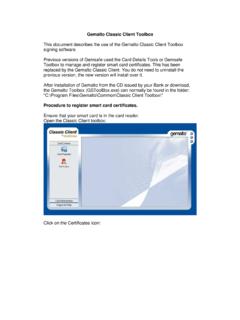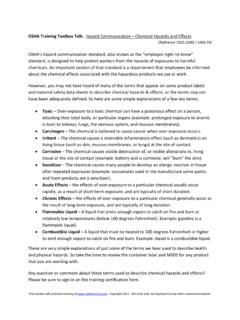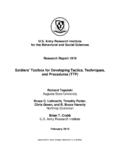Transcription of Deer Whistles - DeerCrash.ORG
1 deer Whistles . There are a number of deer -vehicle crash (DVC) countermeasure devices sold to the general public that indicate they use ultrasonic noise to alert deer to the approach of a vehicle. These devices are commonly referred to as deer Whistles . deer Whistles have existed for a relatively long time (they were introduced in the late 1970s) and have even been distributed to drivers by some insurance companies for a reduced fee rate. The primary objective of deer whistle devices is to alert a deer by producing a noise that draws their attention and reduces the risk of a DVC occurring ( , the deer freezes or flees). The manufacturers of these devices, for the most part, indicate that they produce ultrasonic noise in the range of 16 to 20 kilohertz (kHz). The devices reportedly produce this noise (which is outside the range of human hearing) as air passes through them.
2 Typically, the manufacturers indicate the device operates on vehicles traveling 30 miles per hour (mph) or faster, and that the ultrasonic noise can be heard up to about a 1/4- mile. More recently, some noise-related devices have also been introduced, but are not air- activated. These devices are electronically powered and can be designed to produce the manufacturer specified level of noise at any vehicle speed. No studies or independent analysis of just electronic devices was found in the literature. A few studies, however, were discovered that considered the effectiveness of air-activated deer Whistles and the hearing capabilities of deer (1, 2, 3, 4, 5, 6, 7). One of these studies also included electronic Whistles , but the possible difference in effectiveness between them and air- activated Whistles was not the focus of the investigation (3). These studies are discussed in the following paragraphs.
3 Literature Summary The DVC reduction effectiveness of deer Whistles has not been vigorously studied. Much of the literature reviewed consisted of non-scientifically defined anecdotal evidence as its basis for an effectiveness discussion. However, there have been some very specific declarations made about the DVC reduction effectiveness of deer Whistles based on this type of approach. The scientific validity of this type of claim was considered questionable by the authors of this toolbox and they are not repeated. Another method that has been used to evaluate the effectiveness of deer Whistles appears to include the comparison of safety or crash data for a group of governmental agency vehicles (typically one to several hundred) before and after the device was installed. Typically, the time period considered before and after the devices were installed was months, years, or not documented.
4 A general discussion of the results from these types of studies is briefly described in the following text. The primary weakness of this research is typically the small sample size, length of time period considered, and general lack of control comparison. Published documents that focus on the effectiveness of deer Whistles and also describe the study design and results were found in only a few instances. These studies are discussed in this summary. An analysis that considers the hearing capabilities of white- tailed deer is also summarized. Before-and-After Evaluations Some before-and-after studies have attempted to evaluate the effectiveness of air- activated deer Whistles . The details of few of these studies have been properly documented. One study in Onodaga County, New York was documented (1). The Sheriff's Department in the count y mounted deer Whistles on 55 patrol cars (1).
5 The documentation for the devices indicated that they were supposed to activate at vehicle speeds above 30 mph and be heard by animals at a distance of 400 yards (1). In an October/November 1988 newsletter article about the devices it was reported that only two patrol cars had struck deer since 1986 and that five others had sustained minor damage avoiding collisions with deer (1). Before the installation of the devices the county sheriff's department experie nced about 10 DVCs each year (1). It was suggested by the author of the newsletter article that the Whistles need to be checked often so that they did not become plugged, and that extra caution needs to be used in areas with vertical and horizontal roadway curvature because the noise might not propagate well in these areas. The results from an analysis of the fleet vehicle whistle experience at the Idaho National Engineering and Environmental Laboratory have also been documented (2).
6 This article indicated that the laboratory fleet experienced no crashes during the five years after the device installation, but had an average of 17 per year before the devices were installed (2). The authors of this study also acknowledged that conflicting results had been produced by studies that focused on the effectiveness of these devices (2). The typical variability in the number of DVCs experienced by the governmental agencies and/or the general public was not addressed in either document. On a larger scale, seve ral different types of air-activated and electronic deer Whistles were provided free of charge to 1,648 drivers of Modoc County, California (3). The Whistles were distributed to people that responded to the newspaper advertisement, and their license plate numbers recorded (3). The drivers were responsible for whistle installation and maintenance, but the adequacy of these activities was not confirmed (3).
7 From 1998 to 2000 it was indicated that about 23 percent of the reported collisions in this county were animal related (primarily mule deer ) (3). A statistical analysis was used to compare the 2001 and 2002 actual and expected number of DVCs for the 1,648 vehicles with Whistles (3). Assuming that every vehicle in the county had an equal chance of being involved in a DVC, it was determined that the vehicles with Whistles should have experienced a total of six DVCs (3). However, no DVCs actually occurred (3). This difference was determined to be statistically significant by the authors of this report, and they believe the Whistles were the reason for this reduction (3). No discussion of the natural variability in DVCs in the area was addressed. A similar approach was taken to compare the DVC involvement rate of vehicles with and without Whistles to the crash patterns that occurred before the Whistles were distributed.
8 Not surprisingly, the same conclusion was reached with respect to the effectiveness of the Whistles (3). The authors of the Modoc County study document, however, recognized that several factors weakened the validity of these results (3). These factors include the small number of DVCs that occurred during the two years of the study and the impact of characteristics outside the control of the researchers ( , severity of the winter and number of mountain lions) (3). Additional concerns with the results include the inherent assumption that all vehicles have the same probability of being involved in a DVC, and that the Whistles were all installed and maintained adequately throughout the study time period. It might also be argued that drivers who take advantage free Whistles are especially aware of the DVC problem, and this could impact the results of this study. These confounding factors limit the validity, transferability, and usability of the results from this study (despite the large number of vehicles involved).
9 In contrast, the Insurance Institute for Highway Safety also published a status report in which it reviewed at least two studies that appeared to produce the opposite result of those indicated above (4). First, an article from the mid-February 1993 Farm Journal was reviewed that stated the Ohio State Police, after installing deer Whistles on their patrol vehicles, did not experience a DVC reduction (4). In addition, it was also stated that the Georgia Game and Fish Department had not observed, during hundreds of encounters, any deer response to vehicles with deer Whistles installed (4). Device Effectiveness During January/February 1990, Romin and Dalton studied the response of mule deer to vehicle- mounted deer Whistles (5). Two brands of air-activated Whistles were separately mounted to the front of a truck and their impact evaluated on wild mule deer . These Whistles had what were considered to be typical manufacturer specifications ( it was expected they would produce an ultrasonic sound of 16 to 20 kHz at vehicle speeds greater than 30 mph, and that could be heard by deer at or closer than 1/4-mile or 400.)
10 Yards). The study was conducted along a 6 mile segment of dirt roadway in the Gordon Creek Wildlife Management Area of Carbon County, Utah (a winter range for mule deer ). The impact of each whistle was tested by driving the test truck in both directions at 40 mph past groups of deer within 62 feet of the roadway. The first pass drive by of the vehicle was completed without Whistles to acclimate the deer to the truck noise, and to get a better idea of how the responses changed with the addition of the whistle . The second drive by of the vehicle, in the opposite direction, was competed with the Whistles . The response of the deer , and their distance to the vehicle was recorded for each pass. A. response by a group of deer was considered equal to one of them lifting its head, changing its orientation, running away from the truck, or running toward the truck (5).






